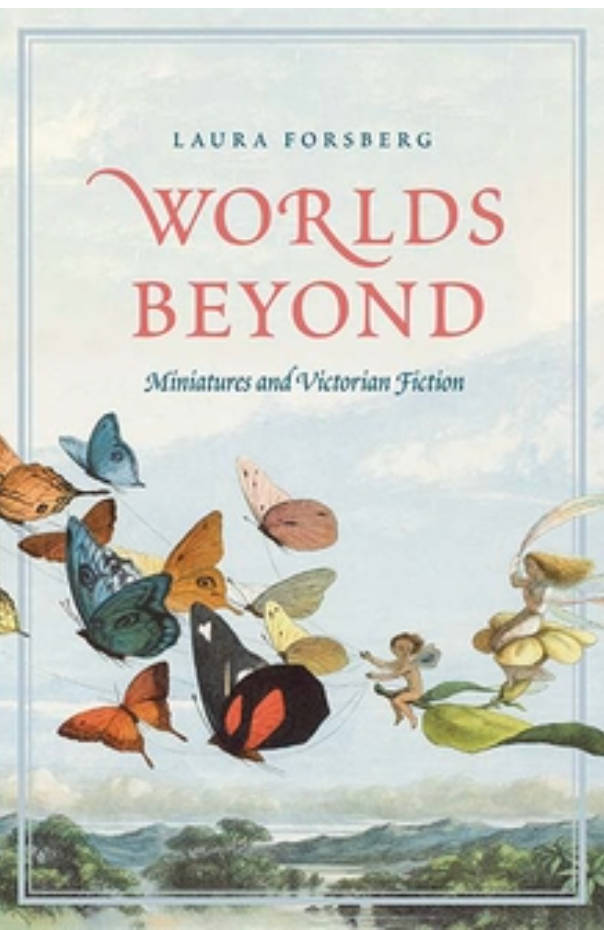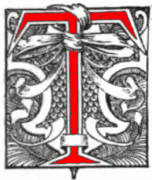Thanks to Review19 and Professor Golden for sharing her review with readers of the Victorian Web. — George P. Landow

 his book brings to the field of material culture studies a sustained attention to Victorian things that are "particularly easy to overlook" (2): a two-inch manuscript, a miniature portrait that fits in the palm of a hand, the contents of a doll's house, water droplets under a microscope, the marvel of a fairy. Forsberg's book is impressive in its scope, cutting across disciplines--science, the book arts, art history, children's play, and literature--and incorporating both canonical and little- known works; doll's narratives and fairy science tracts take their place beside novels by Austen, Thackeray, Eliot, and Dickens. Tantalizing ephemera--portrait miniature collections, dolls and dollhouses, and series of miniscule books--enrich this potpourri of small objects that fascinated the Victorians and functioned as emissaries of events, technological achievements, familial ties, and cultural norms.
his book brings to the field of material culture studies a sustained attention to Victorian things that are "particularly easy to overlook" (2): a two-inch manuscript, a miniature portrait that fits in the palm of a hand, the contents of a doll's house, water droplets under a microscope, the marvel of a fairy. Forsberg's book is impressive in its scope, cutting across disciplines--science, the book arts, art history, children's play, and literature--and incorporating both canonical and little- known works; doll's narratives and fairy science tracts take their place beside novels by Austen, Thackeray, Eliot, and Dickens. Tantalizing ephemera--portrait miniature collections, dolls and dollhouses, and series of miniscule books--enrich this potpourri of small objects that fascinated the Victorians and functioned as emissaries of events, technological achievements, familial ties, and cultural norms.
In her Introduction, Forsberg links this study of miniscule and microscopic Victorian things to landmark texts in the field, including Bill Brown's 2001 Critical Inquiry essay "Thing Theory" and Elaine Freedgood's The Ideas in Things (2006). Importantly, Worlds Beyond also builds upon an examination of objects in Victorian literature and culture dating back to Asa Briggs's Victorian Things (1988; revised 1996, 2003). But this book shows even more clearly how the miniature took its its place among the small and large items that the Victorians used, collected, displayed at the Great Exhibition, discarded, recycled, and bequeathed.
This well-researched book comprises four parts--miniaturization in art, science, childhood, and the book--with a following coda. From these chapters we learn how miniature likenesses on vellum or ivory promoted intimacy in requiring close proximity to be viewed; how the microscope conquered the limits of the naked eye by revealing worlds that could not have been seen before; and how miniaturization pushed the bounds of possibility and raised new questions: if there are microbes teaming in water droplets of the Thames when observed through a microscope, might fairies also exist, and dolls come to life?
Forsberg's transitions are excellent. Having analyzed the microscope and the fairy, for example, she begins Chapter Five by noting: "Whereas the microscope and the fairy opened up new worlds to view, the dollhouse possessed the capacity to represent the entire known world in small" (135). Likewise, she notes in Chapter Six: "Just as the microscope offered material grounding for a fairy imaginary, authorizing a literature in which the fancy of fairies in the garden gave way to an interest in the natural world, so too toys inspired speculative fictions in which a single toy could transport the child into new worlds and exotic spaces" (165).
Each of the four parts surveys the history of miniature objects that preceded the Victorian age but flourished in it. Besides describing at length the materials used to make miniature objects, Forsberg explains how owners engaged in real and imaginative play with these tiny marvels, how technological advances impacted the rise or decline of a type of miniature (photography eclipsed the portrait miniature), and how authors used miniature objects to develop plot and characterization. To highlight a few examples, the ivory from British India on which portrait painter Sir William Charles Ross created miniatures of the royal family illuminates the power of the British empire across space. Portrait miniatures are what Forsberg calls powerful "objects perpetually in motion" (54); concealed, displayed on a wall (as is George Osborne's miniature in Vanity Fair [1848]), or worn on a person, these miniature portraits link owner to subject, present to absent, public to private, and past to present. Intangible tiny objects also stirred the imagination. What could not be "heard, tasted, or touched," Forsberg writes, "possessed an illusory quality, as if they belonged to a dream or to fairyland" (84). Connecting very adult concerns with the realm of childhood, her treatment of fairies leads us to imagine "worlds beyond," as this book is aptly titled.
Chapters Five and Six seem most original in examining the dollhouse as a scene for child development and imagination in the nineteenth century. The modern dollhouse, first the domain for adult women in the sixteenth century, became installed in the Victorian nursery. With scalar power over toys, children used them to exercise their imaginations or try out adult roles and responsibilities. Imagining the reality of her toys, Forsberg writes, a child might "enter into the space of dollhouse life despite her physical size that rendered this an impossibility" (145). These two chapters show how often authors--notably the Brontës --played with their toys, and how such play was fictionally represented by leading Victorian children's authors, including Lewis Carroll and George MacDonald.
Part Four, "Miniatures and the Book," is one chapter numbered 7. Here Forsberg consciously adopts "the methods of the collector, describing the idiosyncrasies of individual volumes, in order to trace how the nineteenth-century fascination with miniature books led to a growing interest in the volume's promise of infinite knowledge, condensed into a physical form that fit into a pocket" (194). Though this chapter surveys a fine collection of miniature books filled with vast quantities of information, it treats the material even more briskly than the previous chapters do.
For all the plenitude of her examples, however, many are insufficiently examined. While Chapter 2 surveys what writers ranging from Jane Austen to George Eliot do with the portrait miniature in 47 novels, and while elsewhere Forsberg offers a list of doll narratives, she is most illuminating when writing at length about a particular work of fiction--such as Julia Pardoe's Lady Arabella, or, The Adventures of a Doll (1856), to which she gives two and a half pages. Forsberg felicitously includes Tinkerbell in the discussion of fairies, Alice in Wonderland in the speculative fiction section, and the Brontës' Glass Town in the discussion of toys. But these and other examples--Esther Summerson treasuring her doll as an intimate companion in Bleak House (1853) and Maggie Tulliver pounding nails in her fetish in The Mill on the Floss (1860)--require a fuller analysis to tease out the significance of the miniature in Victorian fiction. More sustained development of fewer literary examples would have strengthened this book for an academic audience.
In the Coda, "Miniatures after the Victorian Age," Forsberg uses Queen Mary's dollhouse (constructed 1921-24) to make an argument that ties together much of the material in the four parts of this book. With the shift to perfection in the creation of miniatures that 20th-century technology allowed, she explains, came a reduction in the viewer's "guesswork, extrapolation, and exploration" (223), eclipsing the Victorian portal to worlds beyond. Cutting the penultimate paragraph on the smartphone (which could become a promising paper unto itself) would have lent greater coherence to both the Coda and the book. Forsberg's concluding paragraph makes an "open invitation to my readers to explore the many miniature worlds still waiting to be discovered and described" (224); we can easily imagine readers making this very connection between Victorian miniaturization and digital miniaturization, which shows no sign of abating. Surprisingly and regrettably in a book published by Yale, Worlds Beyond makes errors in content and punctuation that should have been corrected before it went to press. Most glaring is the reference to the portrait miniature of a "George Sedley" in Thackeray's Vanity Fair. Forsberg aptly analyzes Amelia Sedley's obsession with the portrait miniature of her misnamed husband, noting "the portrait miniature of George will never be unfaithful to her, will never ask anything of her, and will never change" (65). However, her misnaming of Amelia Sedley's husband, George Osborne, as "George Sedley"-- which appears on page 3 and recurs on pages 55, 64, and 65--gave me pause. This error is compounded by others. An apostrophe referring to the collective "Brontës" is misplaced in a header (168) but happily corrected to "the Brontës' periodical" a few pages later (172). On pages 66, 78, and 80 we are told again, again, and again what is first stated on page 66: that photography replaced portrait miniatures. On page 100, an illustration called "Monster Soup" is mislabeled as Fig. I.1 (located on page 2), but "Monster Soup" is actually Fig. I.2 (placed on page 16). Such errors--which could be perpetuated if Forsberg is quoted--could have easily been caught with better copy editing and should be fixed if the book goes into a second printing.
Also disappointing is the treatment of illustrations. In the Victorian age, pictures have narrative value and were designed to be "read." There is little or no mention of important illustrators including John Everett Millais, George Cruikshank, and Richard Doyle. Even Doyle's illustration of fairies (see below), which adorns the dust jacket, gets only one sentence in the text (117).

Richard Doyle, The Fairy Queen Takes an Airy Drive in a Light Carriage, a Twelve-in-hand, Drawn by Thoroughbred Butterflies. 1870.
Setting these points aside, Worlds Beyond makes a persuasive case for the miniature as a way of understanding the Victorians and their world. It amplifies the field of material culture studies by showing how miniaturization made the familiar appear new and strange, "blurr[ing] the boundaries between science and imagination, between what is and what could be" (2). Thanks to Forsberg's book, the miniature will no longer be easy to overlook.
Bibliography
Forsberg, Laura. Worlds Beyond: Miniatures and Victorian Fiction. New Haven: Yale University Press, 2021. xii + 284 pp.
Last modified 25 September 2018